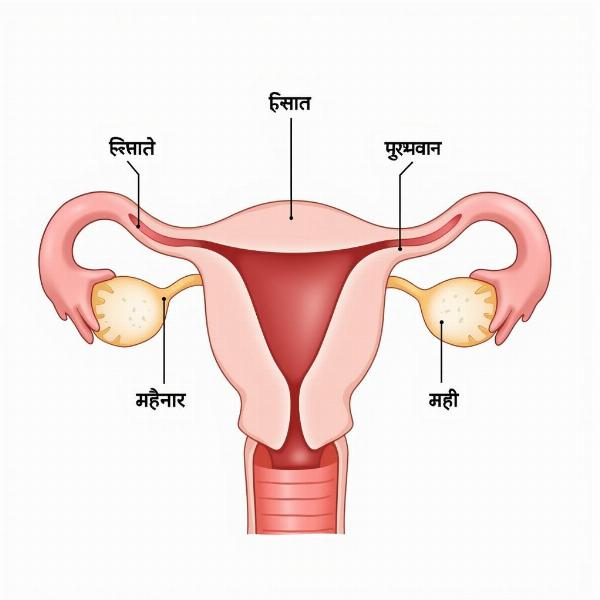Understanding the meaning of “external genitalia” in Hindi is crucial for clear communication in medical, educational, and personal contexts. This article explores the various Hindi terms used for external genitalia, addressing both male and female anatomy, while also considering cultural sensitivities and common misconceptions. Finding the right terminology can be challenging, especially given the diverse dialects and regional variations across India. This article aims to provide a comprehensive guide to help you navigate this sensitive topic with accuracy and respect.
Understanding the Term “External Genitalia”
The term “external genitalia” refers to the outwardly visible reproductive organs. In Hindi, several terms exist to describe these organs, often varying based on region, dialect, and level of formality. It’s important to choose the appropriate term based on the context and audience. Using precise language ensures clarity and avoids misunderstandings, especially in medical or educational settings.
Hindi Terms for Male External Genitalia
For male external genitalia, common Hindi terms include bahirang jananendriya (बाहरंग जननांग), shishn (शिश्न), and ling (लिंग). While bahirang jananendriya is a more formal and medically accurate term, shishn and ling are more commonly used in everyday conversation. However, it’s worth noting that ling can also refer to the phallus as a symbol in religious contexts, so its usage requires sensitivity. Other terms like purush jananendriya (पुरुष जननांग) exist, literally translating to “male reproductive organs,” but these encompass both internal and external structures.
 Male External Genitalia Diagram
Male External Genitalia Diagram
Hindi Terms for Female External Genitalia
Female external genitalia are often referred to as bahirang jananendriya (बाहरंग जननांग) or yoni (योनि) in Hindi. While yoni is a more common and traditional term, it carries broader connotations beyond just the external genitalia, sometimes encompassing the entire female reproductive system and even having spiritual significance. stree jananendriya (स्त्री जननांग) translates to “female reproductive organs” and includes both internal and external structures. Other terms like bhaga (भग) and vulva (वल्वा), borrowed from Sanskrit and English respectively, are also used, but require caution due to potential cultural sensitivities.
Cultural Sensitivity and Appropriate Usage
Discussing external genitalia in Hindi, like any language, requires cultural sensitivity. While certain terms are medically accurate, their usage in casual conversation might be considered inappropriate. It’s essential to be mindful of the context, audience, and relationship with the person you’re communicating with. For example, using formal terms like bahirang jananendriya is generally preferred in educational or medical contexts, while informal terms might be acceptable within close family or friend circles. Remember, choosing the correct terminology demonstrates respect and understanding.
Common Misconceptions and Clarifications
Misconceptions surrounding external genitalia and their functions are common. Openly discussing these topics using accurate terminology can dispel these myths and promote a healthier understanding of sexual health and reproduction. Educating oneself about the correct anatomical terms is the first step towards accurate communication and fostering open discussions about sexual health.
Why Understanding the Correct Terminology Matters
Using accurate terminology when discussing external genitalia in Hindi is crucial for several reasons. In medical settings, clear communication between doctor and patient is essential for accurate diagnosis and treatment. In educational settings, correct terminology facilitates learning and understanding of human anatomy. In personal contexts, using appropriate language promotes respect and avoids misunderstandings.
Conclusion
Understanding the various Hindi terms for external genitalia is important for effective and sensitive communication. By using accurate and appropriate language, we can promote clear understanding in medical, educational, and personal contexts. This article provides a comprehensive overview of the relevant terms, emphasizing the importance of cultural sensitivity and dispelling common misconceptions. Remember, using precise language promotes respect and understanding, allowing for open and informed discussions about sexual health and anatomy.
FAQ
-
What is the most formal Hindi term for external genitalia? Bahirang jananendriya (बाहरंग जननांग) is the most formal and medically accurate term.
-
Is it appropriate to use the term yoni in casual conversation? While yoni is a common term, it carries broader connotations and may not be appropriate for all casual conversations. Consider your audience and relationship.
-
Why are there so many different terms for the same thing? Regional variations, dialects, and levels of formality contribute to the variety of terms used.
-
Where can I learn more about sexual health in Hindi? Reputable online resources and medical professionals can provide further information.
-
Why is it important to use the correct terminology? Accurate terminology ensures clear communication, avoids misunderstandings, and promotes respect.
Meaning-Hindi.in: Your Partner for Accurate Hindi Translations
Meaning-Hindi.in is your one-stop solution for all your Hindi translation needs. We specialize in providing accurate and culturally sensitive translations across various domains, from business and legal documents to technical manuals and educational materials. Our team of expert Hindi linguists ensures that your message is conveyed with precision and respect. Whether you need document translation, website localization, or interpretation services, Meaning-Hindi.in is committed to delivering high-quality translations tailored to your specific needs. Contact us today at [email protected] or +91 11-4502-7584 to discuss your project and receive a free quote.